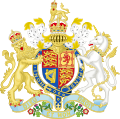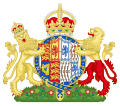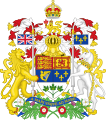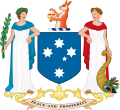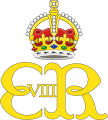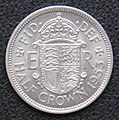Tudor Crown (heraldry)

The Tudor Crown, also known as the Imperial Crown, is a widely used symbol in the heraldry of the
History

The heraldic depictions of the royal crown have undergone many changes in their form and enrichment. The crown began to assume its present form in the reign of
After the restoration of the monarchy, Charles II based the royal crown on the new St Edward's Crown, which had four crosses pattée alternating with four fleurs-de-lis, the number of arches was reduced to two and the curvature of the arches being depressed at the point of intersection. On this pattern the royal crown was depicted until the reign of Queen Victoria.[2]
While various crown symbols had been used for this purpose for many years previously, in 1880 after Queen Victoria became
In 1952 Queen Elizabeth II requested the design be replaced with a representation of the St Edward's Crown which she wore at her coronation. Many, though not all, of the derived designs around the world were updated to match.[2]
In Canada, the Tudor Crown has been used since 1907 in the Canadian Government Inspection Legend on inspected meat products. The inspection legend (or symbol) consists of two concentric circles: the outer ring has the word "Canada" at the top and a number at the bottom identifying the place of production; the inner circle contains a black and white rendering of the Tudor Crown.[citation needed]
Following the death of Elizabeth II, the design of King Charles III's royal cypher was announced on 27 September 2022, which featured the Tudor crown rather than the St Edward’s Crown. According to the College of Arms, this depiction will now be used in representations of the Royal Arms, badges and military uniforms.[5]
Gallery
Coats of arms
-
Royal coat of arms of the United Kingdom(2022–present)
-
HM Government(2022–present)
-
Royal coat of arms of the United Kingdom(1901–1952)
-
HM Government(1901–1952)
-
Coat of arms of Queen Alexandra, consort of Edward VII
-
Coat of arms of Queen Mary, consort of George V
-
Coat of arms of Queen Elizabeth, consort of George VI
-
Coat of arms of Queen Camilla, consort of Charles III
-
Seal ofAnnapolis
-
Coat of arms of Australia (1912–1953)
-
Coat of arms of Queen's University Belfast
-
Royal arms of Canada(1921–1957)
-
Crest ofRoyal College Colombo(pre–1954)
-
Coat of arms of the University of Dublin
-
Badge of Royal Netherlands Air Force 322 Squadron
-
Coat of arms of Northern Ireland (1924–1972)
-
Coat of arms of the Orange River Colony (1904–1910) and the Orange Free State (1910–1925)
-
Coat of arms of Queensland (1902–1953)
-
Coat of arms of Singapore (1948–1959)
-
Coat of arms of British Somaliland (1950–1953)
-
Coat of arms of the Straits Settlements (1901–1946)
-
Coat of arms of Victoria(1910–1953)
Cyphers
-
King Edward VII
-
Royal cypher ofKing George V
-
Royal cypher ofKing Edward VIII
-
Royal cypher ofKing George VI
-
Royal cypher ofKing Charles III
-
Dual cypher of Charles III and Queen Camilla
-
Design element ofQueen Elizabeth the Queen Mother's 90th birthday commemorative coin, 1990
Flags
-
Flag of Annapolis
-
Coronation Standard of Australia (1937 and 1953)
-
Flag of the governor-general of Australia (1902–1908)
-
Flag of the governor-general of Australia (1908–1936)
-
Flag of the governor-general of Australia (1936–1953)
-
Flag of The Bahamas (1904–1923)
-
Flag of The Bahamas (1923–1953)
-
Flag of thegovernor of The Bahamas(1904–1953)
-
Flag of the governor general of Canada (1901–1921)
-
Flag of the governor general of Canada (1921–1931)
-
Flag of the governor general of Canada (1931–1953)
-
Flag of thegovernor-general of Ceylon(1948–1953)
-
Flag of the Colony of Fiji (1903–1908)
-
Flag of the governor of Fiji (1903–1908)
-
Coronation Standard of India (1937)
-
Flag of thegovernor-general of India(1901–1947)
-
Flag of the governor-general of India (1947–1950)
-
Flag of the British Indian Army (1942–1947)
-
Flag of Llandovery
-
Flag of the Colony of Natal (1901–1910)
-
Flag of the British New Hebrides (1906–1953)
-
Flag of the Resident Commissioner of the British New Hebrides (1906–1953)
-
Flag of the governor-general of New Zealand (1936–1953)
-
Flag of Colonial Nigeria (1914–1953)
-
Flag of thegovernor of Nigeria(1914–1953)
-
Flag of Northern Ireland (1924–1953)
-
Flag of the governor of Northern Ireland (1924–1973)
-
Flag of thegovernor-general of Pakistan(1947–1953)
-
Flag of thelieutenant governor of Quebec
-
Flag of Queensland (1901–1953)
-
Flag of the governor of Queensland (1901–1953)
-
Flag of theCrown Colony of Singapore(1946–1953)
-
Flag of thegovernor of Singapore(1946–1953)
-
Flag of the British Solomon Islands (1906–1947)
-
Flag of British Somaliland (1950–1953)
-
Flag of thegovernor of British Somaliland(1950–1953)
-
Flag of thegovernor-general of South Africa(1931–1953)
-
Flag of the governor of Southern Rhodesia (1951–1953)
-
Household flag of the governor of Southern Rhodesia (1940–1952)
-
Flag of the Straits Settlements (1904–1925)
-
Flag of the Straits Settlements (1925–1946)
-
Flag of thegovernor of the Straits Settlements(1904–1946)
-
Flag of Victoria(1901–1953)
-
Flag of the governor of Victoria (1901–1953)
-
Flag of the British Windward Islands (1903–1953)
-
Flag of the Governor-in-Chief of the British Windward Islands (1903–1953)
-
King's Colour for the Royal Navy (1925–1936)
-
King's Colour for the Royal Navy (1936–1952)
-
King's Colour for the Royal Navy (2023–present)
-
Ensign of the Royal Irish Yacht Club
-
Ensign of the Royal St. George Yacht Club
-
Ensign of the Royal Jamaica Yacht Club (pre–1953)
-
Flag of the Vanguard Unionist Progressive Party (1972–1978)
Others
-
"Keep Calm and Carry On" wartime poster
-
Scottish police cap badge (worn until 1975)
-
Reverse of a 1953 half crown
-
Crown (Australian coin) 1937, 1938
See also
References
- ^ Boutell, Charles (1864). Heraldry, Historical and Popular. Richard Bentley. p. 318. Retrieved 24 March 2015.
- ^ OCLC 834888.
- ^ Canada, Senate of. "The Rose and Crown: Parliament's royal symbols, part one". SenCanada. Retrieved 2023-11-16.
- )
- ^ "Royal Cypher - College of Arms". www.college-of-arms.gov.uk. Retrieved 2022-09-28.



